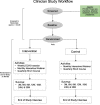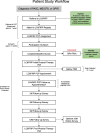A technology-enabled multi-disciplinary team-based care model for the management of Long COVID and other fatiguing illnesses within a federally qualified health center: protocol for a two-arm, single-blind, pragmatic, quality improvement professional cluster randomized controlled trial
- PMID: 37573421
- PMCID: PMC10423413
- DOI: 10.1186/s13063-023-07550-3
A technology-enabled multi-disciplinary team-based care model for the management of Long COVID and other fatiguing illnesses within a federally qualified health center: protocol for a two-arm, single-blind, pragmatic, quality improvement professional cluster randomized controlled trial
Abstract
Background: The clinical burden of Long COVID, myalgic encephalomyelitis/chronic fatigue syndrome (ME/CFS), and other post-infectious fatiguing illnesses (PIFI) is increasing. There is a critical need to advance understanding of the effectiveness and sustainability of innovative approaches to clinical care of patients having these conditions.
Methods: We aim to assess the effectiveness of a Long COVID and Fatiguing Illness Recovery Program (LC&FIRP) in a two-arm, single-blind, pragmatic, quality improvement, professional cluster, randomized controlled trial in which 20 consenting clinicians across primary care clinics in a Federally Qualified Health Center system in San Diego, CA, will be randomized at a ratio of 1:1 to either participate in (1) weekly multi-disciplinary team-based case consultation and peer-to-peer sharing of emerging best practices (i.e., teleECHO (Extension for Community Healthcare Outcomes)) with monthly interactive webinars and quarterly short courses or (2) monthly interactive webinars and quarterly short courses alone (a control group); 856 patients will be assigned to participating clinicians (42 patients per clinician). Patient outcomes will be evaluated according to the study arm of their respective clinicians. Quantitative and qualitative outcomes will be measured at 3- and 6-months post-baseline for clinicians and every 3-months post assignment to a participating clinician for patients. The primary patient outcome is change in physical function measured using the Patient-Reported Outcomes Measurement Information System (PROMIS)-29. Analyses of differences in outcomes at both the patient and clinician levels will include a linear mixed model to compare change in outcomes from baseline to each post-baseline assessment between the randomized study arms. A concurrent prospective cohort study will compare the LC&FIRP patient population to the population enrolled in a university health system. Longitudinal data analysis approaches will allow us to examine differences in outcomes between cohorts.
Discussion: We hypothesize that weekly teleECHO sessions with monthly interactive webinars and quarterly short courses will significantly improve clinician- and patient-level outcomes compared to the control group. This study will provide much needed evidence on the effectiveness of a technology-enabled multi-disciplinary team-based care model for the management of Long COVID, ME/CFS, and other PIFI within a federally qualified health center.
Trial registration: ClinicalTrials.gov, NCT05167227 . Registered on December 22, 2021.
Keywords: Chronic fatigue syndrome (CFS); Long COVID; Myalgic encephalomyelitis (ME); Post COVID-19 conditions (PCC); Post-infectious fatiguing illnesses (PIFI).
© 2023. BioMed Central Ltd., part of Springer Nature.
Conflict of interest statement
The authors declare that they have no competing interests.
Figures
References
-
- Comparisons of early and late presentation to hospital in COVID-19 patients. 2020. - PubMed
-
- Centers for Disease Control and Prevention. Long COVID or Post-COVID Conditions. 2022 [cited 2019 May 19]. Available from: https://www.cdc.gov/coronavirus/2019-ncov/long-term-effects/index.html#:....
-
- Yale Medicine. [cited 2021 Oct 20]. Long COVID (post-acute sequelae of SARS CoV-2 infection, PASC). Available from: https://www.yalemedicine.org/conditions/long-covid-post-acute-sequelae-o...



